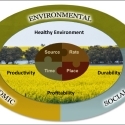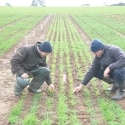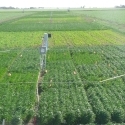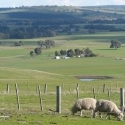24 Feb 2017
Impacts of a wet season on crop nutrition
GRDC Advisor Update Presentation and Paper
 Barley Crop
Barley Crop
2016 was one of the wettest cropping seasons all across southern Australia, with flooding and transient waterlogging seen in many areas. As well, some areas also experienced late frosts which reduced crop yields where they hit.
Despite this, the overall winter grain production in Australia is estimated at a record of 59 million tonnes, almost 50% higher than 2015 and 13 Mt more than the previous record in 2011-12. Australia produced 35.1 Mt of wheat, 13.4 Mt of barley, and 4.1 Mt of canola.a rise of 56.1 per cent on 2015-16. It is also expected the stored moisture in soils and storages will see summer cotton and rice production increase, although sorghum production seems likely to ease.
In preparing to the 2017 winter crop season, there are a couple of points to consider in terms of nutrition, and these were summarised at the GRDC Advisor Updates in Adelaide, Wagga Wagga and Bendigo, as well as the growers update at Rupanyup. The main points from those discussions are:
- Supply of N from the soil to the crop is a consequence of several competing processes driven largely by temperature, aeration and soil carbon supply. In 2016 across much of the area that “survived” flooding, recovery was good and spring mineralisation rates likely contributed to the high efficiencies of N use seen.
- The timing of applied N affects the balance of N to yield and N to protein. Late N was a risk/reward strategy, largely balancing lodging risk and haying off against the protein boost. Even with favourable conditions - achieving higher protein requires some luck with post-anthesis conditions.
- The wet 2016 may have leached the more mobile nutrients, such as nitrogen (N), sulphur (S) and maybe potassium deeper into the profile which suggests at-sowing rates may need to be raised for these nutrients to ensure they remain at adequate levels in the developing root zone.
- Given the uncertainty of N supply across paddocks, an N-rich strip may be a useful tool to monitor in-crop N supply.
- Soil testing, although far from perfect, is still the best method to assess nutrient supply to guide the right fertiliser rate. Assessing subsoil nutrient supply, particularly of N and S, will be important to get a picture of the potential subsoil nutrient supply in a wet profile and to ensure nutrients are supplied at the right time.
- Getting the right nutrient source at the right rate, right time and right place is the basis of good nutrient management. To find out more about the 4R's approach, visit http://www.ipni.net/4r.




